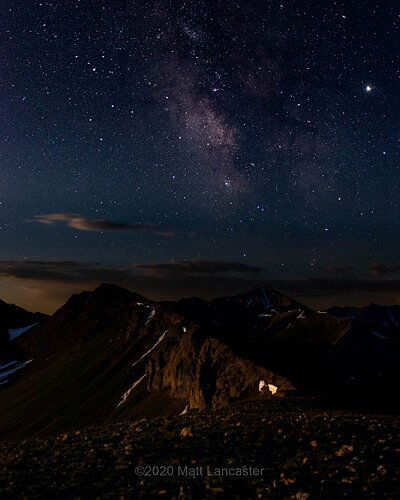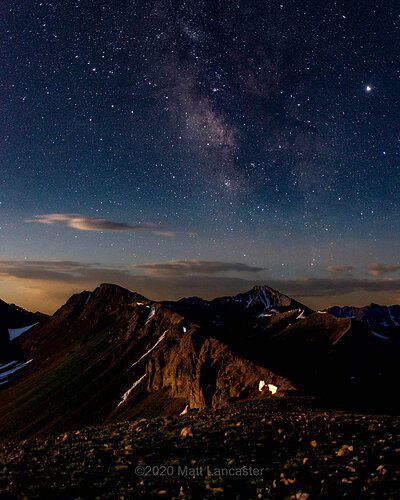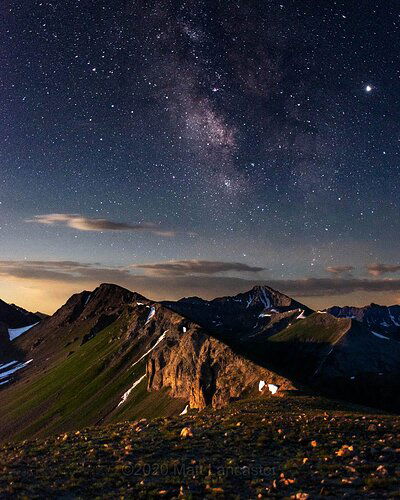Once in a while my technique converges with the conditions and planning to produce an exciting image. On this occasion, I read the full moon would rise an hour or so after sunset. I also saw on PhotoPills that the Milky Way’s galactic center would sit sufficiently high to enable a photo over a terrestrial subject.
So I backpacked to a ridge on the Continental Divide with amazing 360deg views, including this view south to Grizzly Peak. In the moments following sunset all the favorable conditions came together and I tripped the shutter with a big smile on my face.
This is a single frame:
NIkon D610
Nikkor 28-70mm at 28mm
15.0 sec
f/2.8
ISO 3200
LR processing
What technical feedback would you like if any?
Any
What artistic feedback would you like if any?
Any
1 Like
You made a very interesting photo and the dark horse is easily visible. My only criticism is the apparent airplane or jet light in the sky. There are a lot of nice oblique lines in the landscape, leading your eye around the image. I wonder what it would look like if it was a bit darker, and more convincing of the night sky?
1 Like
Astonishingly successfull result of your planning. Donna’s suggestions make sense. To my eye, the bright snsno on the left and some rocky foreground might be happily cropped out.
1 Like
Great planning and determination to get this image.
I like the concept, but the image feels like a daylight image with a Milky Way to me. I would look at a much darker version of the image to help balance the night time light and not have the foreground look like it was early morning or late afternoon.
1 Like
@donnaclarke, @Dick_Knudson, @Keith_Bauer, thank you for your comments. Yes, I agree, this first one was quite bright - I have a lot to learn still on processing astro images. I’ve noticed I tend to process my daytime images dark and my nighttime images light. Go figure.
I reposted a second attempt to take the brightness down quite a bit while retaining the detail in the moonlit landscape elements. I also cloned out the airplane lights. Would love to hear your thoughts.
Matt, wheres the comet ? Didn’t you know that you can’t post a night-scape image without including comet Neowise these days ? 
First let me say this is an outstanding job of pre-planning an image. The composition is very strong, with great depth and wonderful zigzagging lines. What a outstanding setting to shoot the Milky Way. I just love the arrangement of the mountains.
Regarding the processing of this image as originally presented, there seems to be two schools of thought. Some folks will accept your initial post for what it is, an artistic rendering of a night image to appear as if it is daytime. It’s not intended to reflect the reality of what our eyes would see. Other folks see it as not “looking like night”, and prefer a darker night-time vibe. I don’t think either interpretation is right or wrong, it’s a vanilla vs. chocolate thing (if you are not a nature purist).
I like your initial post as an artistic (but not realistic) interpretation. I think your rework goes too far into the darker camp. If you want to go darker, I might try aiming for something in-between, more of a twilight feeling. It’s all subjective.
1 Like
Matt:
@Ed_McGuirk’s post looks great to me. Somewhere between your original and your second option.
For me it feels much more natural with a nice balance.
1 Like
Thanks, @Ed_McGuirk and @Keith_Bauer. I agree - in fact, I was reworking some more to strike a balance between the initial post and the rework as you were commenting. My 2nd rework is posted above.
Ed, I agree about the vanilla vs chocolate presentation of images - I tend to avoid realism and lean toward abstraction, mystery, or just plain fantasy as you are well aware. My goal with this image is somewhere closer to realism - hence the rework and genuine interest in comments and suggestions on processing. Thanks as always - I appreciate your feedback.
One of the things you have in the first image is the strong diagonal lines. When you rework the image and it gets too dark you lose that design element. I agree with the above commenters that somewhere between dark and light is probably best for the composition. I am new to the Milky Way photography but I have a good teacher-- and that’s why I had commented above about the airplane. From what I’ve learned, it’s okay to have the streak from the space station or sometimes a lightning bug, but not from an airplane! G
o figure.
1 Like
@donnaclarke, I agree about airplane lights. I overlooked editing them in the original post and am glad you pointed them out.
And you are right that my first rework diminished the diagonal lines of the ridges. I brought them back in the second rework although not to the degree that Ed did.
Thanks for your feedback!
Matt, I definitely like the darkest image the best. To see the Milky Way it must be really dark, I think there is no place within a radius of 50km of my home town where I can see it. Too much light pollution.
So almost any image of the Milky Way feels unnaturally in my opinion, if there is detail to be seen in the FG. As @Keith_Bauer mentioned, the first image is like a dayight image with a M.W. The 3rd image is, to my eye, like a beautiful evening sky after sunset, but with a M.W. In the real world you might see the first, brightest stars coming out. So I prefer the 2nd, with a nice balance between FG and sky. But I realize of course that there is always a comprimise, and a matter of taste, because to do justice to reality the FG should probably be completely black. And that is not what you’re aiming at.
That said, the darkest image is something that is certainly worth your big smile. Beautiful FG, nice lines and a great sky. Nice hike probably too 
1 Like
Thanks, @Han_Schutten. It was a truly magical experience - the hike was only about a mile from the trailhead at Independence Pass, with all of it above treeline beginning at an elevation over 12,000’. Skies at that elevation and location, as you can imagine, are extremely dark without a moon and the site is popular with astrophiles during new moons.
Your take on exposure reveals just how wide interpretations of MW photos can be - from very dark to represent the actual conditions, to bright for photos that show the glorious landscape but are clearly unreal. Until I process more of these and develop my own vision for them, I am on the fence. Thanks for expression your vision for what you prefer - it’s all good and something to learn from.




